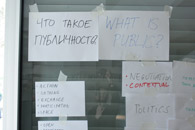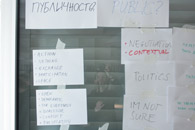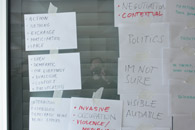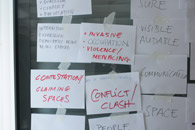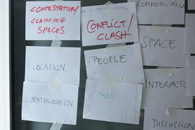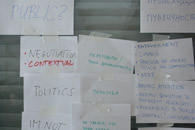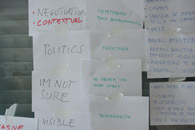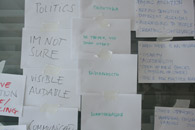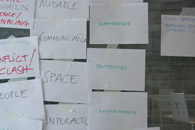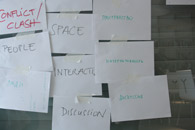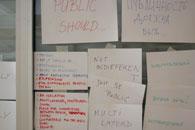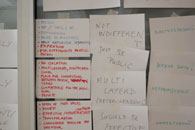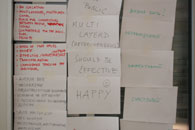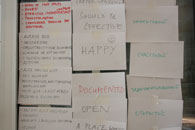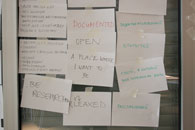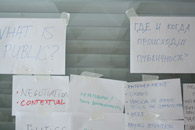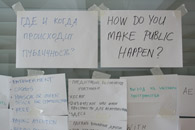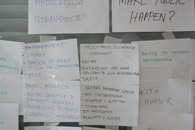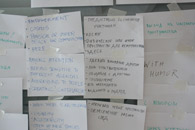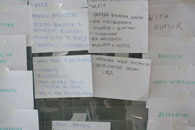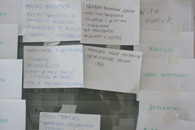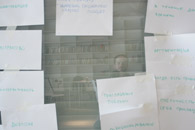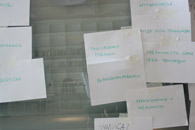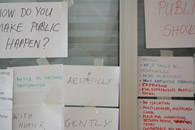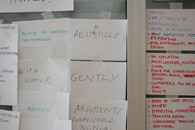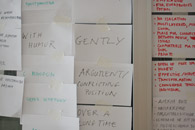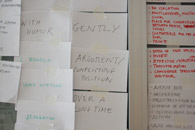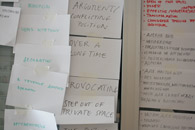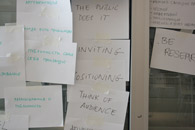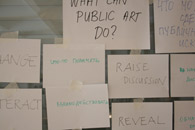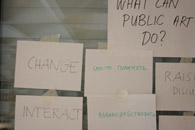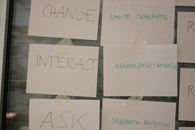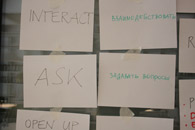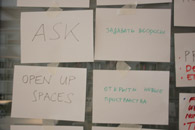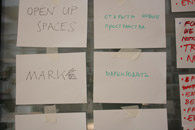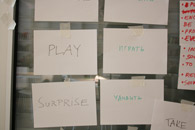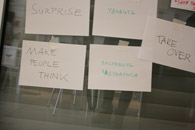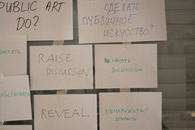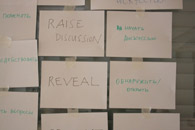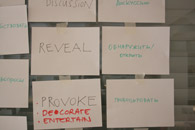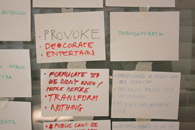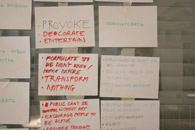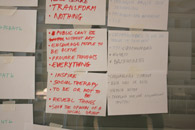Going Public Lexicon
Initiated during the kick-off workshop in Vilnius by the Museum of Contemporary Art Leipzig and «Well-Connected» - Academy of Visual Arts Leipzig, the Going Public Lexicon explores different understandings of the public, as well as diverse approaches to public art, aiming to associatively situate artistic and curatorial perspectives of the region in a broader international context.
The lexicon is based on definitions and keywords mapped during the Vilnius workshop where participants answered four fundamental questions relating to notions of the public sphere and the role and potential of public art. Click on the keywords to read the statements contributed by Going Public participants and to have a look at curated examples from regional and international actors from the contemporary art field. More...
What is public?
Contestation/claiming spaces
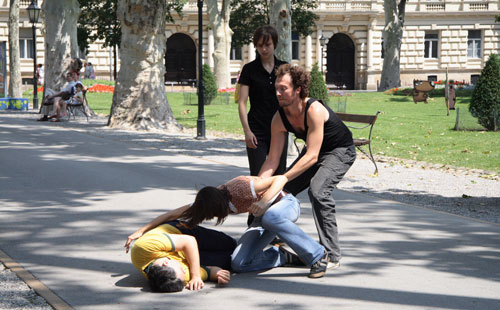
Igor Grubić, East Side Story, Zagreb, Belgrade, 2006-2008
The aim of the project East Side Story was to tackle the question of the rights of sexual minorities in the society that shows a violent reaction to diversity. I was horrified by the cruel response of citizens to the activist's efforts in demanding equal rights for homosexuals during the Gay Parades in Belgrade in 2001 and Zagreb in 2002. Going afterwards through the documented material, I could hardly believe what I saw, terrified by the force of brutality spread among the people only because of their difference. Along with choreographers and dancers, I decided to create dance interventions on the very spots where the events took place, in both cities. This was a way of suggesting the presence of a vivid, creative force very much alike the resistance movement that is trying to change the intolerant, conservative society into a better one.
Spatialisation
Anri Sala, Dammi I Colori, 2003
When former artist Edi Rama became mayor of Tirana in 2000 he immediately set upon a controversial project to enliven the troubled Albanian capital by re-painting the city’s decaying buildings in a riotous array of colour and pattern. An aesthetic and political act, which prompted social transformation, and much debate, through its visualization of signs of change. Three years later Rama and the project became the subject of artist (and friend) Anri Sala’s film, Dammi I Colori. The next year, Rama was voted World Mayor 2004.
Action–Interaction
Action – or “the art of action” – is a current in contemporary art: individual or collective performance (happening, flash-mob) that stages a direct artistic statement in public and / or symbolic public action (e.g. building of barricades on a street in Moscow by Anatoly Osmolovsky, Oleg Kulik performing a dog).
Interaction – interactive action or “the art of interaction” – public artistic actions that encourage viewers (accidental or not) to respond; activating the audience (e.g. “Monstration” – artistic “demonstration” in Novosibirsk by Artyom Loskutov).
Video: Oleg Kulik "I love Europe, she doesn't love me back". September 1, 1996. Kunstlerhaus Bethanien, Berlin.
Interaction
Jiří Kovanda, Kissing Through Glass,10 March 2007
(…) On 10 March 2007 at Tate Modern, from 11am to 8pm, Czech artist Jirˇí Kovanda stood behind a large window, holding up a note asking passers-by to kiss him through the glass. And kiss him they did, an action which, in spite of the physical barrier, was accompanied by embarrassment, hesitation, caution and, occasionally, tenderness. The piece at Tate (Kissing Through Glass, 10 March 2007) was not the first occasion that kissing had featured in the ‘actions’ of Kovanda, who still lives in his native city of Prague. For one of his first ever actions he asked a man and a woman to kiss each other while standing barefoot in freshly mixed concrete. As if noting the results of a scientific experiment, Kovanda then typed his observations on a sheet of paper, including the title – Kiss – location and exact date (11 May 1976). Below this note, mounted on a sheet of paper, are photographs of the protagonists and of their concrete footprints. This action took place in Prague eight years after the invasion of Czechoslovakia by Soviet-led Warsaw Pact troops, during a period of grim totalitarianism that paralyzed many areas of public life. (…) Noemi Smolik
Expression
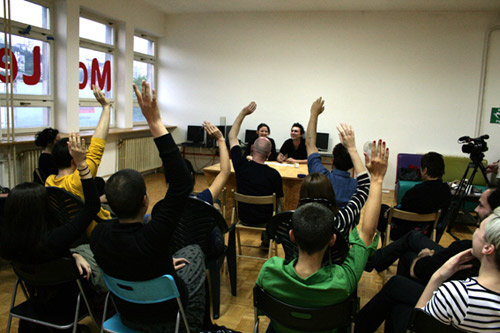
Božena Končić Badurina, DECENTRALISED PERFORMANCE, Rijeka, 2011
The performance began as a meeting where I read my statement in which I give the audience the authority over the performance and invite audience members to make all decisions about the performance (whether or not it should be made, which theme and form it should have).
All decisions were made by majority vote. It was decided to make the performance.
Audience members made many proposals for the performance, a lively discussion developed, but in the end five short collective performances with the most votes were performed (...)
Democratic being
ARTUR ZMIJEWSKI: DEMOCRACIES from Hartware MedienKunstVerein on Vimeo.
Artur Żmijewski, Democracies, 2009-2012
(…)Żmijewski documents various expressions of opinion in public space. The images are left uncommented and shown next to each other without hierarchy or judgement. For the artist, these sometimes extreme and anachronistic rituals of democratic public expression represent the darker side of society, something that has to be tolerated and continually renegotiated in an attempt to reach a public consensus. (…)
being exposed
Real Snow White from Hard//Hoofd on Vimeo.
Pilvi Takala, REAL SNOW WHITE, 2009
The absurd logic of the "real character" and the extreme discipline of Disneyland become apparent when a real fan of Disney's Snow White* is banned from entering the park in a Snow White costume. As visitors are encouraged to dress up and a lot of costume-like merchandise is sold at the park, the full costumes are only sold for children. The Disney slogan "Dreams Come True" of course means dreams produced exclusively by Disney. Anything even slightly out of control immediately evokes fear of the real, possibly dark and perverse dreams coming true. The fantasy of the innocent Snow White doing something bad is so obviously real, that the security guards and management refer to it when explaining why the visitor can’t enter the park dressed up as Snow White.
*Disney’s “Snow White and the Seven Dwarfs” from 1937 is the first full length cel-animated film in history. It’s is based on the fairy tale by the Brothers Grimm.
Team: Raphaël Siboni, Ahmet Ögüt, Pénélope Gaillard, Anna Savolainen
Supported by rijksakademie van beeldende kunsten and Masa Projesi
Violence / Menacing
Given that lately we have witnessed a radical disappearance and/or limitation of public space, i.e. the trend of privatisation of all public goods, even amendments to the law pertaining to gatherings and protests in public areas (which more and more often include the use of repressive methods such as high fines, banishment with the use of excessive force and even detention), one can come to a simple conclusion that violence is becoming a legal instrument used by the government to contend all forms of unwanted actions by individuals and organised groups in public space, including art actions, activist uprisings, demonstrations and other forms of “civil disobedience”. Examples of the said practice are growing by the day, while the most radical examples of imprisonment because of art performances and actions occurred in Russia (during Putin’s last term of office), where members of Pussy Riot feminist collective and some members of Voina art collective were taken to prison on behalf of order and stability. Because of their performances in the public space, directed against Vladimir Putin’s policies, corruption, xenophobia, homophobia…, three members of Pussy Riot and two members of Voina were punished, stripped of their freedom and threatened with incredibly long imprisonment. Therefore, we can safely say that the described cases represent the harshest forms of violence against freedom of speech and creativity, accompanied by a most brutal treatment behind bars, such as different forms of torture (mental and physical), visitors’ ban that extended to even the closest family members, public persecution and blasphemy stigmatisation... To be more specific, Pussy Riot collective acted out a performance on the main altar of Moscow’s Orthodox cathedral in February 2012. The masked girls enacted a political protest against Putin’s third term of office and the support expressed by the Orthodox Church. In the manner of a punk prayer they conducted a performance entitled “Virgin Mary, redeem us of Putin”, for which they are threatened with a severe seven-year prison sentence for “hooliganism”, mainly because of the religious leaders who intervened with the court to handle a case of insulting religious feelings as a criminal act and not a misdemeanour.
Audible
Nicoline van Harskamp, THE POWER OF LISTENING, Amsterdam/Rotterdam, 2009
What happens in our heads when we listen to public speakers? Do the things we hear add up to a collective field of knowledge? Does this field have substance? Does it have language? And can it be made instrumental in politics?
In March 2008, five experts addressed these questions during a public meeting in Theater Frascati, Amsterdam. Nicoline van Harskamp chaired the meeting. Short video clips were shown to illustrate the points of the speakers.
At the end of the meeting, all members of the audience were asked to leave their phone numbers. In the week following the event, an interviewer called up to ask them about what they remembered hearing, seeing and experiencing on the night. Twenty-seven people gave a telephone interview, of between five and forty-five minutes in length.
Interaction
PUBLIC MOVEMENT, SPRING IN WARSAW, 2009
Public Movement is a performative research body that investigates and stages political actions in public spaces. The movement explores the political and aesthetic possibilities residing in a group of people acting together. It studies and creates public choreographies, forms of social order, overt and covert rituals. Among Public Movement's actions in the past and in the future: manifestations of presence, fictional acts of hatred, new folk dances, synchronized procedures of movement, spectacles, marches, inventing and reenacting moments in the life of individuals, communities, social institutions, peoples, states, and of humanity. Public Movement was founded in November 2006 by Omer Krieger and Dana Yahalomi, who led it together until August 2011. The movement is currently led by Yahalomi.
Public should (be) ...
Transformation
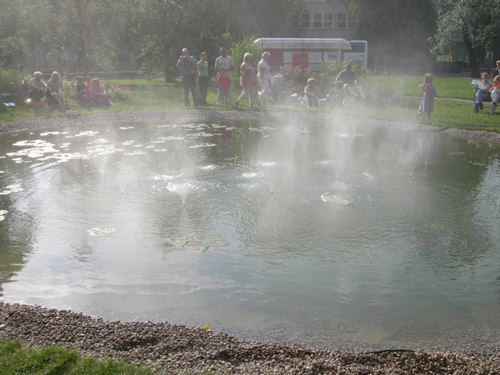
Joanna Rajkowska, Oxygenator, 2007
Oxygenator was a 140 m2 pond installed at Plac Grzybowski in Warsaw, at the edge of the former Jewish ghetto. The pond, complete with greenery, shrubs, water lilies and seats, was equipped with an ozonator and foggers. The oxygenated mist hovering over the area created a refreshing place, a non-monument to breathing.
Plac Grzybowski was an area suspended between different temporal orders, architectural layers and social groups. The proximity of the catholic church, the synagogue, corporate office buildings and small hardware shops created a mosaic of fragmented narratives around the square. The people frequenting the area: nouveau riche from the newly built apartment buildings, elderly people inhabiting the communal flats from the 60s and customers of DIY shops never treated it as a place to stop and talk.
Oxygenator was a new beginning, a green layer growing on the traumatized and neglected social and urban tissue, a literal breath of fresh air. Its mirage-like appearance, impermanence and quietness allowed people not to talk any more about the past but rather physically experience the profound pleasure of being here and now. Oxygenator had no ambition to solve any existing conflicts or create a community. Instead it blurred the existing identities and finally, as a small-scale, local utopia, generated an incredible political energy.
Changeable through the individual
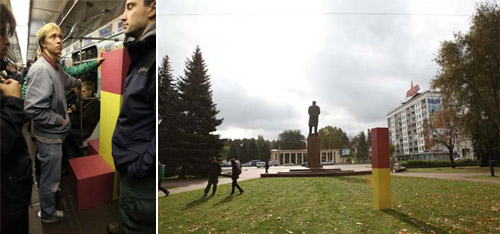
Mikhail Gulin, Personal Monument, 2012
On the 10th of October, in the context of the project “Going Public. On The Possibility of a Public Statement”, well-known Belarusian artist Mikhail Gulin tried to realize his own project “Personal monument”, which rather visually demonstrated the urgency of the surveyed problems.
Mikhail and three volunteers, accompanied by a journalist, moved along the city placing geometrical sculptures on the main squares, which consisted of three red cubes and one yellow parallelepiped. They started from Kalinin Square, then went to Kolas Square and Independence Square. It was planned that the last point of this artistic intervention would be October Square, but special police squad prevented the project from realization by taking artist and his company to the Department of Internal Affairs of Central district of Minsk. They spent 7 hours in the Department, two volunteers were beat up, after that – the report was drawn up and everyone was free.
Expensive
Karmelo Bermejo, 3000 Euro of Public Money Spent Buying Books by Bakunin in Order to Burn Them in a Public Square, 2007
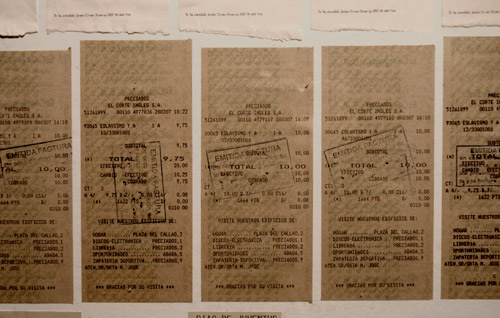
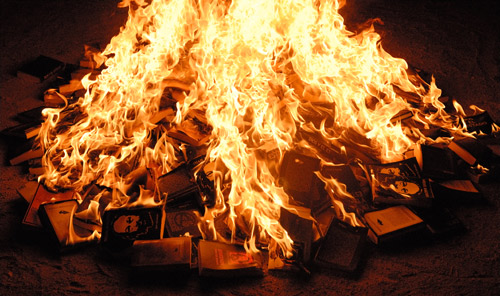
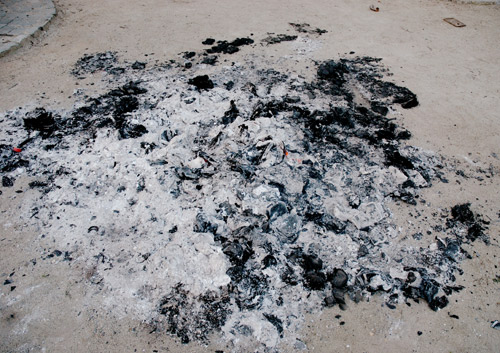
For everybodies’ participation
The possibility of everybody’s participation
It is obvious that the economical crisis is merely a confirmation of the conceptual crisis. Theories of the past that still govern the progress and reproduce a society based on competition exclude an immense segment of potential stakeholders from economical, political and social relationships.
A new, post-economic society, built on a different algorithm of human collaboration, namely, on interdependency, interpenetration and collective action, as well as on networks and symbiotic relations, lifts most of the limitations and fears planted deep in one’s consciousness. For an artist, leaving such a “civilization of clams” behind increases the vitality of the artistic act, when the communication between the artist, his work, and the public becomes a personal adventure, multiplied by a full-fledged and expressive transformation of the environment.
Happy
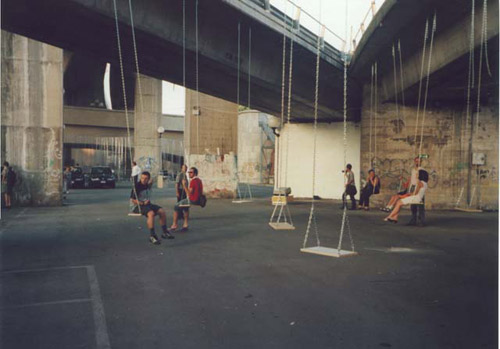
A12 Associati, Swing, 2000
Conceived and realized for The Bridges project as part of Fuori Uso 2000 in Pescara, Italy.
A12 Associati is a professional partnership of architects that have been working in the field between art and architecture at an international level for almost 20 years, working at very different scales, with architectural, exhibit design and urban projects, installations, design and graphic design, promoting various cultural and research activities. A12 has been invited to participate to many different art exhibitions and biennials around the world: Barbican Art Gallery in London, Biennial of Athens, Biennial of Bejing, Biennial of Busan in South Korea, Biennial of Istanbul, Biennial of São Paulo, Biennial of Shanghai, Biennial of Venice, CCA of Kitakyushu in Japan, Cittadellarte Fondazione Pistoletto in Biella, Kröller Müller Museum in Otterlo, MAMCO in Genevre, MAXXI in Roma, MNAC in Bucharest, Musée d’Art Moderne de la Ville in Paris, PS1 in New York, Santa Monica Museum of Art in Santa Monica,Triennale of Milano, Villa Manin in Passariano di Codroipo, ZKM in Karlsruhe, etc. A12 also develops didactic activities at the Politecnico of Milano, at the Domus Academy and at the Naba in Milano.
Since 2004, the current group members work together under the title of A12 Associates, based in Milan. At present, A12 Associati members are: Andrea Balestrero, Gianandrea Barreca, Antonella Bruzzese, Maddalena De Ferrari, Massimiliano Marchica.
A place where I want to be
Lena Krasit, Experiment #3, Lena is a sailor, 2012
So, folks! Exactly one month ago (it was April) Lena started to swim. Everyone applauded to her, as during the parade – everyone from Komsomolskayja lake up to Nemiga, Gorky park and the factory “Kristal”. Lena was swimming on athe rubber mattress through the entire city of Minsk. We highly recommend that you repeat this experiment yourself after watching the video!
No isolation
7:55 PM, the city of Minsk, the central Karl Marx street. Today is Sunday, which means that one third of the street is closed for car traffic, and for the next 24 hours it is going to be a pedestrian zone. Following the idea of “European standards”, a promenade zone for the citizens’ idle pastime was created in the capital of Belarus in late May. It would seem that the authorities, who hold a monopoly on determining the course of events in the city’s public space, have taken a step towards transgression of the limits of their personal interests. Yet the citizens do not feel safe and confident in this allotted space of free movement and continue strolling along the paved sidewalks, going across the street only at zebra crossings, as if following the instructions deeply ingrained in their mind: “cross the street only at designated crosswalks”. The sterile urban space, paved with neutral grey tiles, puts the citizens into a clearly defined system of movements and routes. Moving along clear landmarks – sidewalks, crosswalks, etc., the person loses touch with the surrounding environment and the things taking place around, including their own intentions and directions. Their movement is accompanied by an endless stream of flickering posters: “This is my city”, “Minsk – the capital of your homeland”, “Love your city”, “We are Belarusians”, which create a vacuum for the perception of any other message with their meaninglessness. Meanwhile, the street is silent too: music is not to be heard near the café tables, the neon lights of the store signs do not glow. Only the languid benches facing the pedestrian zone will remind of this designated free movement area tomorrow.
NO isolation as the idea of the possibility of restoring public space on our own through small-scale acts of art activism; as the rejection of the media’s hegemony of public space; as the rejection of alienation of people.
Comfortable for the individual
Julius von Bismarck in collaboration with Julian Charriere, Some Pigeons are more equal than others, Copenhagen, Venice 2012
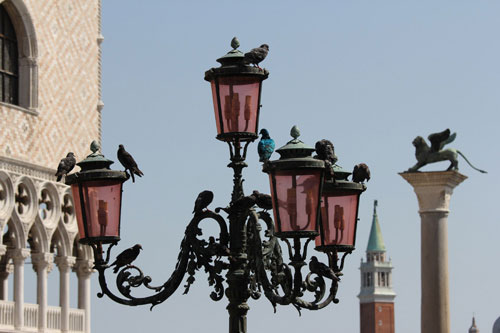
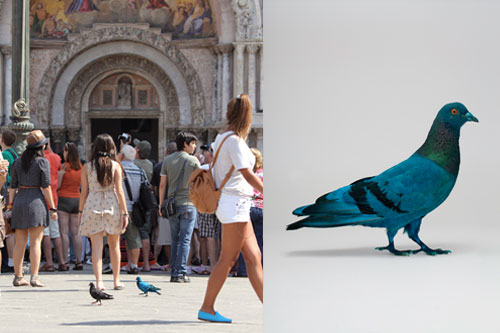
How do you make public happen?
Empowerment
Arguments–conflicting positions
Chantal Mouffe: Artistic Activism and Agonistic Spaces
The Public SpaceWhat are the consequences of the agonistic model of democratic politics that I have just delineated for visualizing the public space? The most important consequence is that it challenges the widespread conception that, albeit in different ways, informs most visions of the public space conceived as the terrain where consensus can emerge. For the agonistic model, on the contrary, the public space is the battleground where different hegemonic projects are confronted, without any possibility of final reconciliation. I have spoken so far of the public space, but I need to specify straight away that, we are not dealing here with one single space. According to the agonistic approach, public spaces are always plural and the agonistic confrontation takes place in a multiplicity of discursive surfaces. I also want to insist on a second important point. While there is no underlying principle of unity, no predetermined centre to this diversity of spaces, there always exist diverse forms of articulation among them and we are not faced with the kind of dispersion envisaged by some postmodernist thinkers. Nor are we dealing with the kind of ’smooth’ space found in Deleuze and his followers. Public spaces are always striated and hegemonically structured. A given hegemony results from a specific articulation of a diversity of spaces and this means that the hegemonic struggle also consist in the attempt to create a different form of articulation among public spaces.
Art&Research – A Journal of Ideas, Contexts and Methods
Volume 1. No. 2, Summer 2007 (Excerpt from article),
Full-length version: www.artandresearch.org.uk
Paying attention
Being sensitive to different agendas
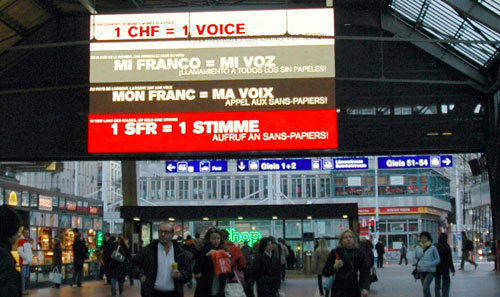
Developed for the exhibition “Work To Do! Self-organisation In Precarious Working Conditions“, curated by Katharina Schlieben & Sønke Gau
Developed for the exhibition Work To Do! Self-organisation In Precarious Working Conditions“, curated by Katharina Schlieben & Sønke Gau
The project was a tool for the illegalized persons in Switzerland* through which they was able to attain visibility on the political and public level. The Sans-Papiers (undocumented immigrants) were invited to donate ONE FRANC for the renovation of the Swiss Parliament (the Parliament building was under renovation), through the account of SPAZ (Center for Illegal Persons in Zurich).
The Parliament is a public voice of the country, and in addressing it they were addressing their request to Swiss society. With this act of donation to society, the Sans-Papiers sent a message that they want to take part in carrying out obligations but also have privileges in the society they are living and working in.
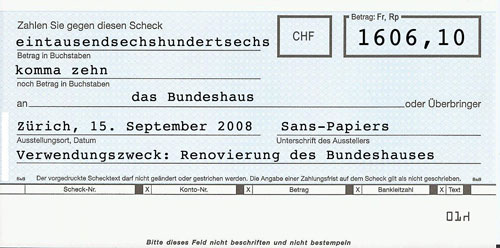
Project Realization
Author: Andreja KuluncicCuratorial Project Assistant: Iris Strobel & Noemie Schwaller
Contributor: Ivo Martinovic
Design: Gumi & Rutta
Project partner: Bea Schwager & SPAZ (Center for Illegalized people in Zurich)
Project organization: Shedhalle & Katharina Schlieben & Sønke Gau
Produced by Shedhalle, 2007-2008
* The activists estimate that about 300.000 undocumented people are living in a precarious situation in Switzerland, the “official” number is 80.000.
Controversy
Controversy is a word composed of two Latin words: contra, against or opposite, and versus, direction or orientation, but also verse. Controversy would then mean something that encompasses both direction and counter-direction. I believe this is one of the possible definitions of art, designing a certain content that alludes to sense, a direction in interpreting reality, with awareness that each individual interpretation is inadequate and thus open to its counter- and anti-interpretation. Word and counter-word. The best of art as the signifying and the never signified. The twentieth century was a century of terror of certainty and sense, a terror of versus and single direction. Communism, fascism, nationalism and various derivatives thereof, followed by economism, subjection of everything to profit, all these had the ambition to capture and adapt the entire life to a single purpose, a single “word”. Such societies, even democratic ones, like to perceive themselves as the embodiments of “normality”, implying finiteness and closure. Therefore I think one of the main purposes of art is to embody the “opposite”, to be “against” and thus to keep the doors to otherness, difference and future always open. Open to life.
Accessibility
Accessibility – well, this is extremely important. A work of art must be exhibited in the public space – in the street or online as opposed to a closed gallery or a private collection; alternatively, the access to it must be open and free – even if it is ensured through a website, a webcam, or something else.
With humor
FAQ on our sect
When do I become Duchamp’s Witness?
When you become a lover of contemporary art, filled with the understanding
about its mission.
How can I answer people who deride and claim contemporary artis not art?
Forgive them for they do not know what they are doing. Help them to discover the truth about contemporary art.
Why are Duchamp’s Witnesses still unpopular topic in many parts of the world?
Many people expect art to simply yield beautiful pictures and decorative objects. They have no courage to face their own prejudices and take responsibility.
Do the Witnesses believe their faith is true?
Yes. Their faith does not recognize racial, class, sexual nor religious differences.
Do they believe they can save the world?
They believe the world can be saved if everyone does a small step.
How do contemporary artists make their living?
Due to reversed social values, they generally live one day at a time. However,
their faith is by their side, at all times.
What is expected of those that attend Duchamp’s Witnesses events in regard to financial contributions?
Duchamp’s Witnesses never collect contributions. Simply bring along - yourself.
Оpen up new spaces (physical or other)
Open up new spaces – abandoned construction sites, entertainment joints, public toilets – all the places suitable for a project, where the place itself would provide the idea and the medium. The Internet, social networks, group chats, etc. I would also consider the Internet, social networks, group chats, etc. in opening up new layers of consciousness, by placing an idea into new, untypical information clusters of the latter.
Inviting
Creativity, often buried under the excrements of heritage and ready-made media images, is embedded in every individual. By continually inviting others, we consciously and consistently get rid of isolation and transform ourselves and our environment into a light, flexible, improvisational interface.
Advertising
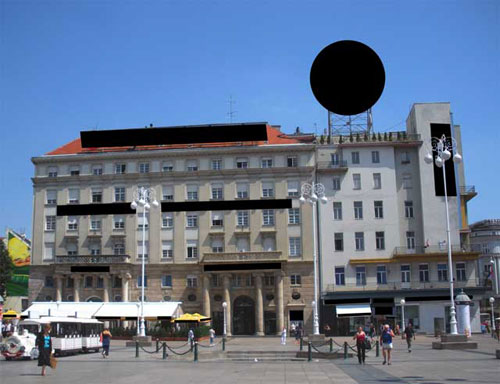
Kristina Leko, in collaboration with [ BLOK ], Zagreb, Suprematism on the Square!, an intervention in public space, 2008, cancelled
Dear Whoever You Might Be, through this web site we invite the citizens of Zagreb and Croatia, but also other interested individuals, to support an endangered artwork which is longing to be realized. By signing your name on our petition page, you will support the public space on the main square in Zagreb, Croatia to be used for a poetic cause.
Under the pressure of the Zagreb Unicredit Group Bank, the Zagreb municipal administration banned the artistic project "Suprematism on the Square!", after it was approved and supported by the same administration as well as by the Croatian Ministry of Culture. Your signature and comments will be appreciated and helpful. Support culture and freedom of artistic expression! Learn more!
What can public art do?
Transform
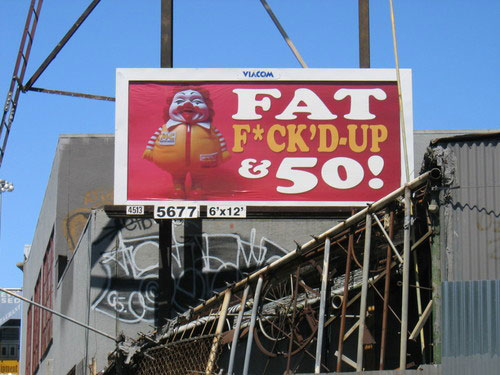
Billboard Liberation Front
Corporate Message from the Billboard Liberation Front
Headquartered in San Francisco, the BLF is a privately-held, worker-controlled shadow entity with no phone number and no permanent address. Our highly secure operating environment and extralegal status guarantee our clients the acme of service, while our internationally recognized creative team delivers unmatched "wow."
Unlike traditional agencies, the BLF is not available for general hire, and offers its services only to an exclusive list of advertisers. Our clients are carefully selected on the basis of a complex formula known only to cabal insiders, and our improvement actions are undertaken on a pro-bono basis, unfettered by the petty demands of clueless executives and weak-kneed middle managers. This unique position of independence allows us unlimited creative freedom, and provides the key to "unlocking" messages that might otherwise have been lost in the bureaucratic natterings of some spineless "account team." We pride ourselves on our total lack of customer service, and our laser-like focus on Message.
Founded in 1977, the BLF is fueled by a single passion: the timely improvement of outdoor advertising. From the humble kiosk insert to the mighty freeway mega-sign, our experienced operatives possess both the technical skills and the creative vision to execute world-class media campaigns.
Entertain
Can public art entertain? Yes and no. I would suggest entertaining viewers can be a by-product of public art, it can even be a tool that is used by the artist to reach or confuse the viewer, but it can never be the goal. Some examples: Anish Kapoor’s Cloud Gate for Chicago’s Millennium Park, or Ron Mueck’s Boy sculpture for London’s Millennium Dome, or Olafur Eliasson’s enormous sun for the turbine hall at Tate Britain. These are star artists, using ‘super sizing’ to their advantage, having huge budgets to work with – like it is common in the Hollywood industry. These works entertain people to no end; they are highly popular, they are used for city marketing, and successfully functioning so. They entertain but they are still works of art, totally perceived by spectators as works of art and not as stunts or rides on the fair.
Public art can entertain at a smaller scale too – as any art work it can make you forget your misery for a bit, make you laugh, make light of grave matters and even come in the guise of superficiality. But just as art should also not be mistaken for politics, or science, or social work, it should not be there only to entertain. An art work needs to do more things, preferably at the same time, possibly even contradicting or conflicting. And most of all art - public or any other kind - needs to make its own agenda.
Social therapy
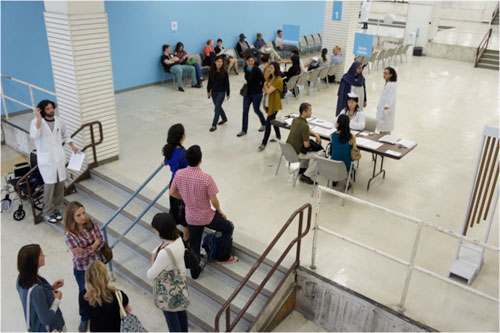
Pedro Reyes, SANATORIUM, 2011
SANATORIUM is a transient clinic which provides short, unexpected therapies. The only way to experience this project is to sign up as a patient.
SANATORIUM starts with an interview where you are diagnosed and then appointed to experience at least 3 of 16 available therapies.
SANATORIUM therapies are variations or mash ups of existing schools such as Gestalt psychology, theater warm-up exercises, fluxus events, conflict resolution techniques, trust-building games, corporate coaching, psychodrama, and hypnosis.
SANATORIUM is a delivery system of placebos. In the same way as a Brechtian play, to be aware of the set up doesn't prevents it from doing the trick. For a skeptical mindset magic has to be deprived of its aura.
SANATORIUM offers a secular space for psychological processes that can be found in religion or shamanism. When you sign in you sign a release form warning you that this is not real therapy nor real therapist. You decide to believe. Suspension of belief has to maintain, eventually you decide to believe, to tell yourself a story.
SANATORIUM works with each individual's own narratives.
SANATORIUM is a democratization of therapy, a 'psychological first aid'. The sessions are conducted by non-professionals. It taps into the excess capacity that we have to help others.
To be or not to be
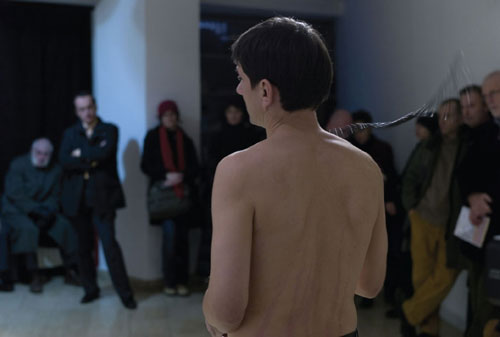
Siniša Labrović, Punishing, 2002 - ongoing
I come in front of the audience with naked upper body and with whip in my hand. When performance starts, nobody can enter and those who go out can not return. The view to the gallery from the outside should be prevented. I am standing still in front of the audience till someone of the visitors don’t give up an leave the gallery. In that moment, when the door are shut from the outside, I hit my back with the whip. Performance lasts till I stay alone in a gallery.
show the opinion of a social group
DOSTA. / Gildo Bavčević from gildo bavcevic on Vimeo.
Gildo Bavčević, DOSTA / ENOUGH 15.10.2011
The wave of discontent spreads throughout the World and the protests become the iconography of today. Even more individuals and groups establish various models of selforganization with the purpose of solving or pointing out the problems for which the responsibles don´t care or don´t want to care. 15.10. of the last year indicates the day of the global protests. On 15.10.2011. thousands of people were on the streets with the sole intention to warn the rest of the society of the need to reorganize and acknowledge the need for deep social changes. They came out to show solidarity and to support the protesters in Egypt, Greece, Wall Street etc. During the protest in Split I directly adressed the guilty party and warned them to stop their evil plans. I made a short and definite transparent in which I also invested a part of me- I spelled DOSTA 15.10.11 with my own blood.
Reveal
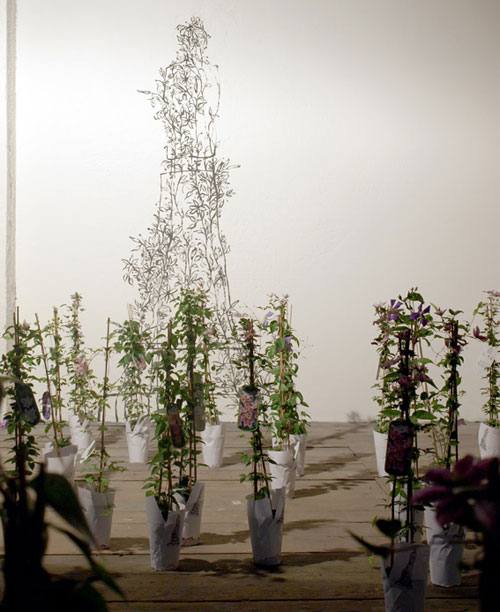
Anetta Mona Chisa & Lucia Tkacova, Far from You, Memorial to Lida Clementisova #50, 2009
Memorial to Lida Clementisova #50 is formulated as an appeal for planting creeping plants (Clematis Hybride) around monuments of all kinds. Eventually, the plants will grow all over the monuments, covering them with flowers and making them temporary invisible. Any actual sculpture can thus become memorial to Lida Clementisova for a while. (…)
Lida Clementisova, Czech opera singer, was the wife of Vladimir Clementis, a Slovak politician and a prominent member of Czechoslovak Communist Party, victime of stalinist "purges" in the 50-ties. She and her husband were both imprisoned for 2 years and tortured before Vladimir's execution. Although her husband was rehabilitated politically and culturally in the 60-ties, Lida Clementisova has never get into collective memory/history. She is forgotten and her name is sometimes marginally mentioned in connection with Vladimir Clementis. (…)
Raise discussion
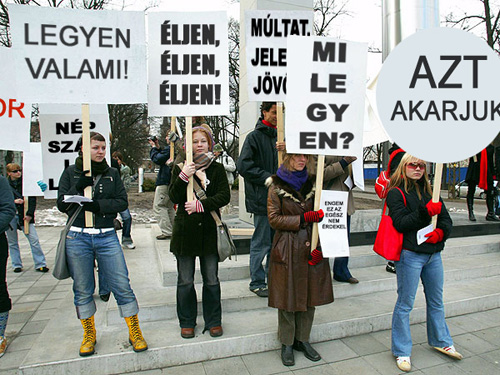
Hungarian Two-Tailed Dog Party, General Demonstration, 2009 Budapest, Hungary
The Hungarian Two-Tailed Dog Party (MKKP) started off as a street art group and later became known as a bogus party. In an atmosphere of the demonstrations of recent years that ever more frequently got drowned by violent acts, MKKP reacts to processes that emptied out political rallies and political culture in general, and attenuated the chances of civil activity and exerting pressure. Its General Demonstration was driven by the motivation to undermine the usual clichés and protest keywords, and parody the very act of demonstration.
On June 21 2009, a different type of rally took place in Budapest: members and supporters of MKKP held a so-called General Demonstration against things that don’t make any sense. Some 200-300 people gathered in front of the Hungarian Central Statistical Office: according to the blog of the demonstration, the reason was that the existence of this office didn’t make any sense. On the art blog Képgyár (”Image Factory”), journalist András Földes reported (HUN) on the Two-Tailed Dog Party's demonstration:
[…] ‘What do we want? Nothing! When? Never!' Protesters in front of the Hungarian Central Statistical Office (KSH) are shouting their demands for long minutes but they can’t gain a hearing. Nobody comes out from the office to receive the petition and to start dialogue.
Though there are enough demands. ‘Let tomorrow be yesterday!' ‘Dissmiss us!' ‘Main stage!' ‘Let's bring everyone who is under the radical sign to a square!' […]
Play
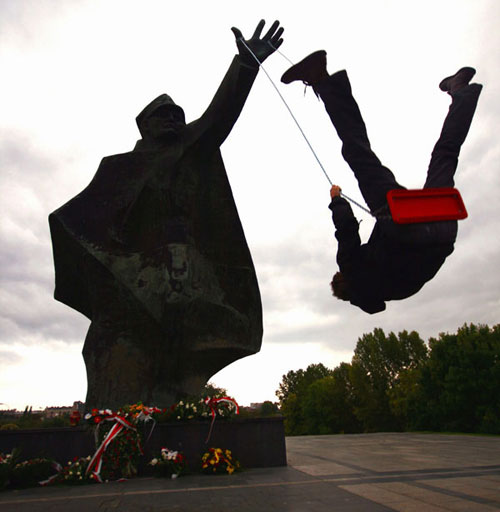
Kamila Szejnoch, Swing, Warsaw, 2008
The project "Carousel Slide Swing" aims to pursue a dialog with memorials that served as communist propaganda. Although such memorials have been consigned to the historical scrap heap, we can still meet them in the streets and parks. To suggest a change in the function of the monuments is an attempt to build a bridge between the present and the past, to add a contemporary layer distinct from their original style and function. For example the idea of Swing is based on a contrast between the monumental bronze Berling Army Soldier and a tiny individual swung by a big hand of history. It is a monument from a former era, but at the same time - from the Berling Army soldier’s point of view - it is a well-deserved tribute paid to his sacrifice. This is an example of how much history can differ from the perspectives of individual and collective memory. My aim is to make this complexity and ambiguity more conspicuous, to show the relation between an individual versus the historical machine.
Mark
S.I.T.E: Screaming In The Everyday, Sydney 2011. from Kusum Normoyle on Vimeo.
Kusum Normoyle, S.I.T.E: Sydney, 2011
Kusum Normoyle is an artist and musician working in the area of extended vocal techniques and noise for both performance and installation.
Core to Kusum’s practice is the idea of intervention, displacing normal expectations of female body and voice. In performance these incursions are brief, extreme and physical. The female scream takes a much heavier tone; more like metal than hysteria, dragging the audience into a harder, faster display of screaming, amplification and feedback.
The provocation is not limited to staged events; they appear in public space such as the city street, empty lane ways or cliff edges, where passers-by become the audience. Confronted by an unexpected display of extreme vocals they try not to look, go about their business, ask if she is ok, mimic and honk their car horns and become immediate fans. These site specific noise events are focused conceptually on a re-distribution of listening, requesting the listener to discover or re-discover their audible contexts, as well as advocating action in these often homogenous environments.
Public can’t be without art
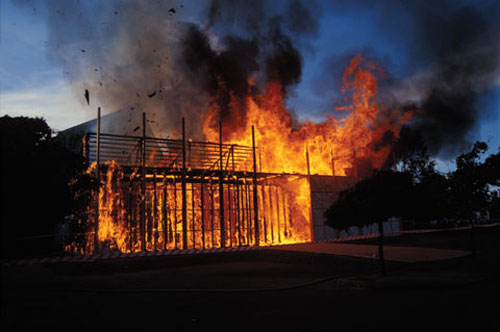
Alfredo Jaar, The Skoghall Konsthall, 2000
(…) I propose to design and build a new, contemporary structure to house the new Skoghall Konsthall. This structure will be built completely in paper produced by the Paper Mill, in close collaboration with local architects and builders.
The design will reflect the best of contemporary Swedish architecture in its minimal elegance and respect for the environment. It will also reflect the generous commitment of the main local industry in the creation of a forward looking structure and institution that will project Skoghall into the future. (…)
The opening exhibition will feature the first exhibition ever held in Skoghall of young emerging swedish artists from Stockholm, Malmo and Gotenburg. The Konsthall will be officially inaugurated by the Mayor of the City, in the presence of the entire local community.
The Closing Ceremony
Exactly 24 hours after its opening, the Skoghall Konsthall will disappear, engulfed in flames. The burning of the structure will be pre-planned and will satisfy the most demanding security requirements.
Epilogue
By its paper nature and design, the Skoghall Konsthall will probably be one of the most advanced contemporary paper structure ever created for contemporary art. But it will also be one of the shortest-lived structures ever created for contemporary art.
I am hoping that this combination of creativity and ephemeral existence will perhaps help define the importance of contemporary art in our lives.
Encourage people to be active
First of all, this means encouraging people to actively reflect on a work of art and independently disseminate the message that the latter contains. Secondly, this also means creating a kind of art that encourages people to change something in themselves or in the world.
Everything
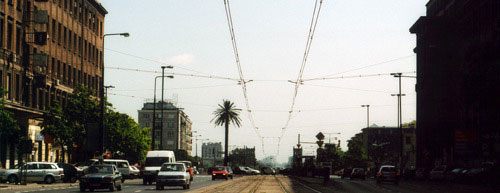
Joanna Rajkowska, Greetings from Jerusalem Avenue, 2002-present Warsaw, Poland
Conceived as a radical social experiment, an imitation of a 15 metre-high palm tree was installed in the middle of a busy roundabout at the junction of Aleje Jerozolimskie and Nowy Świat in Warsaw.
The project originated from Rajkowska’s visit to Israel which made her realize the void left by the absence of the Jewish community in Poland and the significance of Aleje Jerozolimskie (Jerusalem Avenue) to Warsaw, the street's history and etymology. By adding an almost surreally alien element – a tree common in the Middle East, in the spot that previously served as a location for a Christmas tree – the artist used the palm tree to both highlight and challenge the invisibility of the street’s name.
As the Polish expression ‘hit by a palm tree’ refers to something unthinkable, a behaviour that verges on being silly, even idiotic, the project thus embodies substantial humour and irony, which saves it from linear reading and suggests something that escapes palpable understanding. A major element in the scenography for a 24-hour street spectacle, the palm tree undermines and deconstructs situations occurring within its visual reach. Since its creation the palm tree has become the unofficial symbol of Warsaw, Poland.
Entertainment/ Empowerment
I was asked to comment on both these concepts – for me they are part of the same conundrum, so I thought to write on them together. When art goes into public space, is it easier to be an artist or part of the public? What are the difficulties, enjoyments and rewards of being an artist and what are those of being part of the public?
In an article, “Jubilating; Or, How the Atlantic Working Class Used the Biblical Jubilee against Capitalism, with Some Success,” Peter Linebaugh writes a history of the concept of jubilee as a joyful anniversary to come in the future: a year of festivity when the horn will sound for the redistribution of the riches of the land to all people. Today, however, our right to entertainment is being structured, controlled and commercialised to a frenetic extent. Cities are places of capitalising on fun. Yet, when art enters the public sphere it does so in relation to the people, in relation to what is populist or how to engage, address, inspire or be engaged, addressed or inspired by the people. It therefore takes a stance in relation to the capacity to entertain and the potential to empower. How can art make meaning in a popular context?
The specificity of spaces in “Eastern Europe” is that of uneven spatial development, the acute consciousness of an inferiority of our spaces that is not simply economic (it is also acutely economic, but not simply...), but an inferiority of the spaces as spaces. In this context, art and the popular seem particularly divided. This context creates the distinct challenges of public expression in our region.

